Mining Research and Development Projects
Every year, Okane develops new and improved tools, practices, and processes as part of our Research and Development program.
Okane is a pioneer in the mining consulting industry for continually developing techniques and technologies that advance the industry, assist our clients in achieving their goals, and provide added value.
Project Collaborations
On-going Collaboration with the University of Saskatchewan College of Engineering and industry partners.
Scaling up standard industry kinetic tools for predicting long-term water quality has long been a challenge. Okane’s advanced customizable leach columns (ACLCs) are able to closely replicate site conditions to reduce scaling when modelling and provide further information on the evolution of material geochemistry over time. Okane’s ACLCs also provide an advanced and customizable testing system to better predict acid and metalliferous drainage (AMD) generation under site-specific conditions.
Okane is partnering with the University of Saskatchewan College of Engineering (USask Engineering) and industry partners to improve methodology and further investigate the impact of using the ACLCs on scaling factors. By collaborating with research institutions and industry partners, this project will focus on key industry objectives, with results distributed to the larger academic and industrial communities.
Our industry partners have provided in-kind time, funding, and materials from mine rock and tailings storage areas along with the material’s historical data. Results of this research will be immediately implemented into Okane’s ACLC program and, subsequently, inform future storage area designs to reduce the production of AMD at mining sites for other clients with similar waste storage problems.
Okane helped fund the initiation of this project, facilitated collaboration between USask Engineering and industry partners, and provided input to the submission of the NSERC Alliance grant applications. Okane’s team of geochemists and technical experts continue to provide in-kind technical advisory services for the project to guide University of Saskatchewan researchers in column setup and testing procedures.
Works in 2023 included determining project objectives and processes, designing varying column configurations as well as constructing columns. Testing of various waste materials within the columns will begin in 2024.
Project Champion: Mark Phillip, M.Sc.
Mark Phillip is a senior environmental engineer that has been with Okane since 2004 when he moved from New Mexico to Fort McMurray to manage a reclamation monitoring network. He has extensive experience with cover system field trials and performance monitoring systems. His expertise includes integrating laboratory and field testing to assess compaction trials and develop quality assurance/quality control specifications. Okane’s advanced customizable leach columns (ACLCs) provide the opportunity to assess seepage chemistry in a controlled manner representative of in-situ temperature, moisture, and pore gas fluxes. Mark is exploring upgrades to ACLC construction materials, control systems, automated monitoring equipment, and procedures to provide improved confidence in evaluating site-specific in-situ conditions.
Project Champion: Dr. Jared Robertson, Ph.D., P.Eng.
Jared Robertson has been a geochemist with Okane since 2018, focusing primarily on different modelling approaches of acid and metalliferous drainage processes (AMD) and leading the development of Okane’s advanced customizable leach columns (ACLCs) in the Saskatoon laboratory. Jared has provided geochemical support for clients around the world by connecting the geochemistry of their site to improved closure outcomes. Having spent several years in academia, Jared enjoys applying research and development findings to larger scale settings. Developing the industry’s understanding of AMD processes is a critical component to helping Okane’s clients.
Project Champion: Graham Hay, B.Sc., E.I.T.
Graham Hay is an engineer-in-training based in Saskatchewan. Since joining Okane six years ago, he has been dedicated to strategic closure planning, cover system design, and environmental performance monitoring. His experience in strategic closure planning leverages high-level, conceptual thinking to find unique solutions within the mine and closure planning space. Okane’s advanced customizable leach columns (ACLCs) program looks to understand the potential for AMD production under varying oxygen conditions, aiming to formulate a conceptual geochemical model such that strategic solutions may be applied to reduce environmental risks associated with legacy and future mine rock.
On-going Collaboration with Profile Products and the University of Saskatchewan Multi-purpOse Slope Testing (MOST) Facility.
This research focuses on the efficacy of Profile Products soil amendment systems in promoting rapid and early vegetation establishment on and preventing erosion of underlying store-and-release mine waste cover systems. Okane is providing technical advisory services for the project to set and achieve objectives that prioritize industry application.
Currently, this research is in Phase 4, focusing on continuation of development of long-term datasets which assess how the soil amendment systems affect vegetation health outcomes, and how that in turn impacts the hydrodynamics of the sites where they are implemented. Previous phases have demonstrated promising results for vegetation establishment and growth and reduction of erosion rates. For further insights into the Phase 3 research, please refer to the following paper: https://papers.acg.uwa.edu.au/p/2315_049_Sump/.
Past Collaboration with the University of Saskatchewan and the Université du Québec en Abitibi-Témiscamingue.
Laboratory-based predictive tests are often used to determine if AMD will be generated by mine rock or tailings, but these tests do not generally examine the role of microbes in acid-generating processes. It was identified that adding this layer of information (in combination with geochemical and microbiological information from field samples) would identify if the microbiology in ACLCs is representative of field conditions and reproducible among replicate tests in the lab.
The objective of this project was to assess which microbes are present in the ACLCs during testing and how microbes influence the geochemical processes in the columns. This project found there are various types and concentrations of microbes within columns, and thus, it is important to consider field-representative microbial communities in leach column testing, as they can influence sulfur and iron cycling and oxidation processes.
As industry partners, Okane provided funding and in-kind time for the project through the MITACS grant program.
2025
Okane is a leading innovator in predictive modelling for mine material landform management, which are tools to inform management strategies and reduce closure risk.
One of the frameworks Okane uses to assess potential closure risks is our proprietary Mine Rock and Tailings Geo Evolution Model (MIRTAGE), developed as one of Okane’s internal research and development projects.
Our Innovation team is continuing to optimize the MIRTAGE model to decrease modelling turnaround times and increase the accuracy of the software's predictive capabilities. In 2024, work on the model included a review of the potential to incorporate vegetation CO2 sequestration and geochemical tailings consolidation. The focus for Okane’s Innovation team in 2025 will be on optimizing the core model and adjusting the vegetation inputs and tailings consolidation module based on the outcomes of the reviews completed in 2024.
Project Champion: Joel Steeves, MSc, PGeo
Joel Steeves is a senior environmental geologist based in Calgary, Canada, whose work includes a strong focus on numerical modelling of tailings and mine rock storage facilities. His expertise encompasses vadose zone processes, freeze/thaw and frozen soils, the coupling of thermal energy transfer with groundwater flow, and the impacts of climate change. He also specializes in hydrology and hydrogeology, particularly in applying cold-region hydrology and hydrogeology—along with associated thermal energy transfer—to mine closure and cover system design.
Joel has a strong passion for Research & Development since his academic tenure and enjoys applying his skills and expertise to the development of new tools and technologies that address challenges in the mining industry. Over the past several years, he has been heavily involved in the development of MIRTAGE and is passionate about expanding its capabilities to better assess acid metalliferous drainage risks across the different phases of the mine lifecycle.
Emission reduction is one of several global initiatives aimed at addressing global climate change.
CO2 sequestration has the potential to help a site manage its carbon balance. Okane’s Innovation team is leveraging Okane’s Advanced Customizable Leach Columns to compare active and passive CO2 sequestration potential within ultramafic tailings. Understanding the sequestration potential of CO2 through carbon mineralization in ultramafic mine rock and tailings may lead to opportunities for maximizing sequestration and improving mine material storage facility design.
Project Champion: Katherine Raymond, MSc, PGeo
Katherine Raymond is a geochemist based in Ontario, Canada, with a strong geochemistry background and technical experience in mine rock stockpiles and tailings characterization. Throughout her time at the University of British Columbia, she contributed to guidance documents for the reactive transport code MIN3P, and developed models for studies on acid and metalliferous drainage and CO2 sequestration. At Okane, Katherine continues to expand her expertise in reactive transport modelling of mine materials by investigating their CO2 sequestration potential.
Leveraging her previous experience, she will apply findings from previous model sensitivity studies to support design and collection methods in Okane’s ACLCs. The objective of this work is to obtain representative data that enhances our understanding of how to optimize carbon sequestration through carbon mineralization in mining.
Wind erosion and dust generation are persistent challenges on mine sites.
More focus is required on predicting wind erosion and implementing strategies to mitigate the resulting dust transportation and deposition. In 2025, our Innovation team is reviewing available wind erosion models and investigating the potential incorporation of these models into our landform evolution prediction processes. In addition, we will assess available dust mitigation measures. Enhancing our understanding and ability to predict and mitigate dust, will enable us to better assist and support clients with these challenges.
Project Champion: Matt Carson, BEng
Matt Carson is a civil engineer with a background in hydrology, soil science, and cover system performance. He brings expertise in field instrumentation, data acquisition, and numerical modelling to projects aimed at mitigating environmental impacts in the mining industry. His work includes evaluating the performance of cover systems, analyzing soil erosion processes, and optimizing monitoring networks to improve data quality and reliability. By integrating real-time sensor networks with long-term environmental datasets, Matt contributes to the development of innovative solutions for reducing dust emissions and improving air quality in mining operations.
Matt is passionate about driving innovation in environmental monitoring and mine rehabilitation. This innovation is demonstrated through improving the design and implementation of cover systems to enhance stability, reduce net percolation, and support long-term ecosystem sustainability. With a data-driven approach and a commitment to continuous improvement, Matt plays a key role in advancing best practices for mine closure and environmental management.
2024
Okane is a leading innovator in the development of digital twins and predictive modelling for mine waste landform management, which are tools to inform management strategies and reduce closure risk.
Our research and development team is continuing to develop enhanced add-ins to commercially available software to decrease modelling turnaround times and increase the accuracy of the software's predictive capabilities. Additions to the model in 2023 included the development of a tailings consolidation module.
The focus for Okane’s research and development team in 2024 will be improvements to the snow module and reviewing the potential to incorporate vegetation CO2 sequestration and geochemical tailings consolidation.
Project Champion: Luke Kary, BSc, GIT
Luke Kary is a geoscientist-in-training based in British Columbia, with a combined experience in hydrology, geomorphology, and avalanche management. Luke is exploring tools to quantify and map the distribution of winter precipitation across landforms to assist Okane’s clients achieve water management goals. Using data from Okane’s long-term monitoring programs, spatially-distributed numerical models, unmanned aerial vehicle technology, and ground-truthing measurements, he looks to enhance our understanding of snow hydrology and its impacts on mine-affected landscapes.
Project Champion: Joel Steeves, MSc, PGeo
Joel Steeves is a senior environmental geologist based in Calgary, Canada, whose work includes a strong focus on numerical modelling of tailings and mine rock storage facilities. His expertise encompasses vadose zone processes, freeze/thaw and frozen soils, the coupling of thermal energy transfer with groundwater flow, and the impacts of climate change. He also specializes in hydrology and hydrogeology, particularly in applying cold-region hydrology and hydrogeology—along with associated thermal energy transfer—to mine closure and cover system design.
Joel has a strong passion for Research & Development ever since his academic tenure and enjoys applying his skills and expertise to the development of new tools and technologies that can help solve problems within the mining industry and contribute to a more sustainable future.
Emission reduction is one of several global initiatives aimed at addressing global climate change.
CO2 sequestration has the potential to help a site manage its carbon balance. Our Research and Development team is investigating the potential use of Okane's Advanced Customizable Leachate Columns (ACLCs) to kinetically characterize CO2 sequestration by carbon mineralization. Understanding the CO2 sequestration potential by carbon mineralization in ultramafic mine rock and tailings may lead to opportunities for maximizing sequestration potential applying improved mine material storage facility design.
Project Champion: Katherine Raymond, MSc, PGeo
Katherine Raymond is an intermediate geochemist based in Ontario, Canada, with a strong geochemistry background and technical experience in mine rock stockpiles and tailings characterization. Throughout her time at the University of British Columbia, she contributed to guidance documents for the reactive transport code MIN3P, and developed models for studies on acid and metalliferous drainage and CO2 sequestration. At Okane, Katherine continues to expand her expertise in reactive transport modelling of mine materials by investigating their CO2 sequestration potential.
Leveraging her previous experience, she will apply previous findings from model sensitivity studies to help support design and collection methods to obtain representative data in the ACLCs to understand how to better optimize sequestration by carbon mineralization in mining.
Our research and development team continues to develop enhanced add-ins to commercially available software to investigate effective waste management solutions.
Laboratory material characterization results can be used to estimate material properties for modelling, where material analogues are required. A consolidated database of material characterization data is being developed to improve the accuracy of predictive modelling.
Project Champion: Joel Steeves, MSc, PGeo
Joel Steeves is a senior environmental geologist based in Calgary, Canada. His work includes a strong focus on the numerical modelling of tailings and mine rock storage facilities. He specializes in applying cold region hydrology/hydrogeology, along with associated thermal energy transfer, to mine closure and cover system design. His expertise encompasses hydrology and hydrogeology, vadose zone processes, freeze/thaw and frozen soils, the coupling of thermal energy transfer with groundwater flow, and the impacts of climate change. Joel has a strong passion for Research and Development ever since his academic tenure and enjoys applying his skills and expertise to the development of new tools and technologies that can help solve problems within the mining industry and contribute to a more sustainable future.
Mine rock storage facilities are a source of acid and metalliferous drainage and present a significant management challenge for the industry.
Purpose-built construction of these facilities is a strategy that can be implemented to minimize oxygen ingress and as a result, oxidation processes. Our research and development team is investigating the potential to develop a purpose-built in-situ sensor to measure the state of oxidation within a storage facility. Development of this type of sensor will allow direct measurement of a leading performance indicator for mine rock storage facilities purpose-built to minimize AMD drainage.
Project Champion: Andrew Baisley, MSc, PGeo
Andrew Baisley is a senior environmental geoscientist, based in Calgary, Canada. He has extensive experience in planning for mine closure, mine material management, and returning land use. His expertise includes integrating laboratory and field testing to assess mine rock and tailings storage facility construction techniques to mitigate potential future liability. Cover system design, geochemistry, and storage area structural design influences in-situ pore gas composition, which may become suboxic and mitigate the geochemical potential present in an oxidizing environment. Andrew is leading the evaluation of a potential design for an in-situ oxidation state sensor which would provide an opportunity to assess leading indicators of water quality in a controlled manner representative of in-situ temperature, moisture, and pore gas fluxes.
2023
Okane is a leading innovator in the development of predictive modelling for mine landform management-tools to inform upon management strategies and reduce closure risk.
Our research and development teams are continuing to develop enhanced add-ins to commercially available software to decrease modelling turnaround times and increase accuracy of our models’ predictive capabilities.
Additions to the model in 2022 included the development of a thermal module that will support improved modelling of temperature differential through a landform due to convective heat transport by air flow. In 2023, our team is focusing on a tailings consolidation module that will inform the design and planning process for decommissioning and unloading tailings storage facilities during closure.
Project Champion: Robert Shurniak, MSc, PEng
Robert Shurniak is a senior engineer based in British Columbia, with expertise in using and developing numerical models as they relate to mine closure planning. This specifically involves simulating soil-plant-atmosphere and saturated/unsaturated water movement over, around, and through any material or vegetation used in mine operations and closure. Since 2002, Robert has supervised, managed, and advised on numerous numerical modelling projects. Robert leads Okane’s modelling team and ensures our projects benefit from the latest advancements in modelling software. He has developed over 50 long-term climate databases, accounting for historical climate and predicted future climate change, for a range of sites (arctic to arid) around the world. He also has experience designing, installing, and maintaining field monitoring systems and evaluating data from such installations.
It has long been recognized that scaling up of standard industry kinetic tools can be problematic in predicting long term water quality.
Okane’s Advanced Customizable Leachate Columns (ACLCs) assess seepage chemistry in a controlled manner representative of in-situ temperature, moisture, and pore gas fluxes to better replicate site conditions, reducing the need for scaling when modelling.
In 2023, our team is collaborating with research institutions and industry partners to evaluate upgrades to ACLC construction materials, control systems, automated monitoring equipment and procedures to assess the application of the ACLC programs to a wider range of materials and site conditions.
Project Champion: Mark Phillip, MSc
Mark Phillip is a senior environmental engineer based in Butte, U.S.A., leading Okane's Environmental Monitoring and Advanced Data Management. He has extensive experience with cover system field trials and performance monitoring systems. His expertise includes integrating laboratory and field testing to assess compaction trials and develop quality assurance/quality control specifications.
Okane’s ACLCs provide the opportunity to assess seepage chemistry in a controlled manner representative of in-situ temperature, moisture, and pore gas fluxes. Mark is exploring upgrades to ACLC construction materials, control systems, automated monitoring equipment, and procedures to provide improved confidence in evaluating site-specific in-situ conditions.
2022
Okane is a leading innovator in the development of predictive modelling for mine landform management-tools to inform upon management strategies and reduce closure risk.
Our research and development teams are continuing to develop enhanced add-ins to commercially available software to decrease modelling turnaround times and increase accuracy of our models’ predictive capabilities.
Additions to the model in 2022 included the development of a thermal module that will support improved modelling of temperature differential through a landform due to convective heat transport by air flow. In 2023, our team is focusing on a tailings consolidation module that will inform the design and planning process for decommissioning and unloading tailings storage facilities during closure.
Project Champion: Robert Shurniak, MSc, PEng
Robert Shurniak is a senior engineer based in British Columbia, with expertise in using and developing numerical models as they relate to mine closure planning. This specifically involves simulating soil-plant-atmosphere and saturated/unsaturated water movement over, around, and through any material or vegetation used in mine operations and closure. Since 2002, Robert has supervised, managed, and advised on numerous numerical modelling projects. Robert leads Okane’s modelling team and ensures our projects benefit from the latest advancements in modelling software. He has developed over 50 long-term climate databases, accounting for historical climate and predicted future climate change, for a range of sites (arctic to arid) around the world. He also has experience designing, installing, and maintaining field monitoring systems and evaluating data from such installations.
Okane regularly collaborates with research institutions to help drive innovation and share learnings with industry.
Our technical experts are assisting researchers with the development of an in-depth tool for climate and soil-plant-atmosphere analysis, and to evaluate how climate change is influencing current monitoring, spatial variability, and cover system performance changes with time.
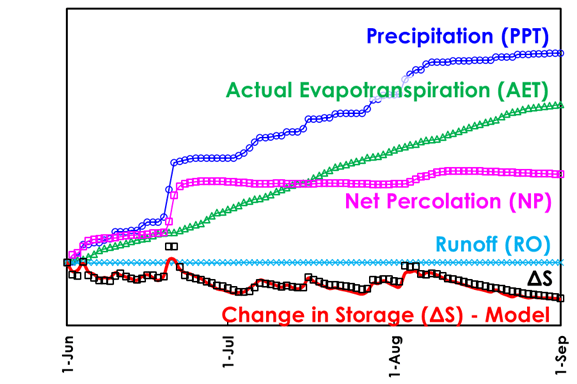
Project Champion: Robert Shurniak, MSc, PEng
Robert Shurniak is a senior engineer based in British Columbia, with expertise in using and developing numerical models as they relate to mine closure planning—specifically, simulating soil-plant-atmosphere and saturated/unsaturated water movement over, around and through any material or vegetation used in mine operations and closure. Since 2002, Robert has supervised, managed, and advised on numerous numerical modelling projects. Robert has developed over 50 long-term climate databases, accounting for historical climate and predicted future climate change, for a range of sites (arctic to arid) around the world. He also has experience designing, installing, and maintaining field monitoring systems and evaluating the results from such installations.
Robert is the Numerical Modelling Group Leader for Okane and he ensures all modelling projects are completed to Okane’s high standards using state-of-the-art modelling software. Research and development of new modelling tools to assist with mine closure are a priority at Okane. For example, mine rock storage (MRS) typically generates approximately 80% of a site’s overall acid rock drainage and metal leaching (ARD-ML) load. Modelling tools are important for determining the impetus for ARD-ML generation at a given site and to test potential mitigation methods.
Okane has extensive experience in simulating water balances for application in water management and cover system performance estimates.
Our research and development team are in the process of validating a commercially available hydrological model used to estimate snow water equivalent in catchments for inputs into water balances.
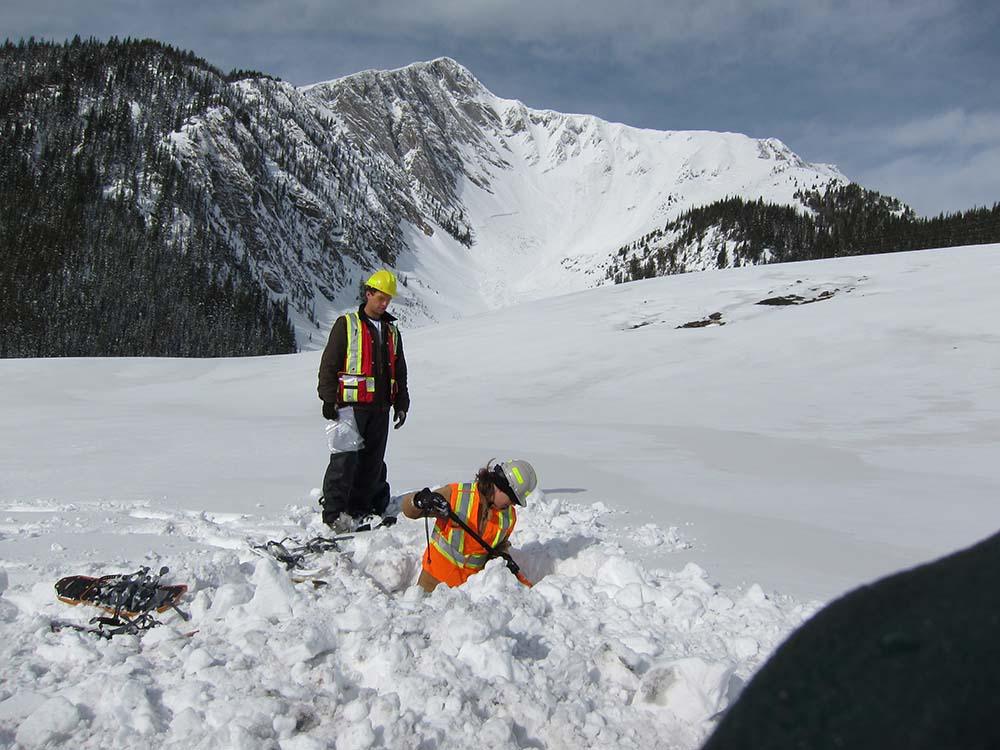
Project Champion: Luke Kary, BSc, GIT
Luke Kary is a geoscientist-in-training based in British Columbia, with a combined experience in hydrology, geomorphology, and avalanche management. Luke is exploring tools to quantify and map the distribution of winter precipitation across landforms to assist Okane’s clients achieve water management goals. Using data from Okane’s long-term monitoring programs, spatially-distributed numerical models, unmanned aerial vehicle technology, and ground-truthing measurements, he looks to enhance our understanding of snow hydrology and its impacts on mine-affected landscapes.
Okane is pioneering solutions to achieve returning land uses in mine planning.
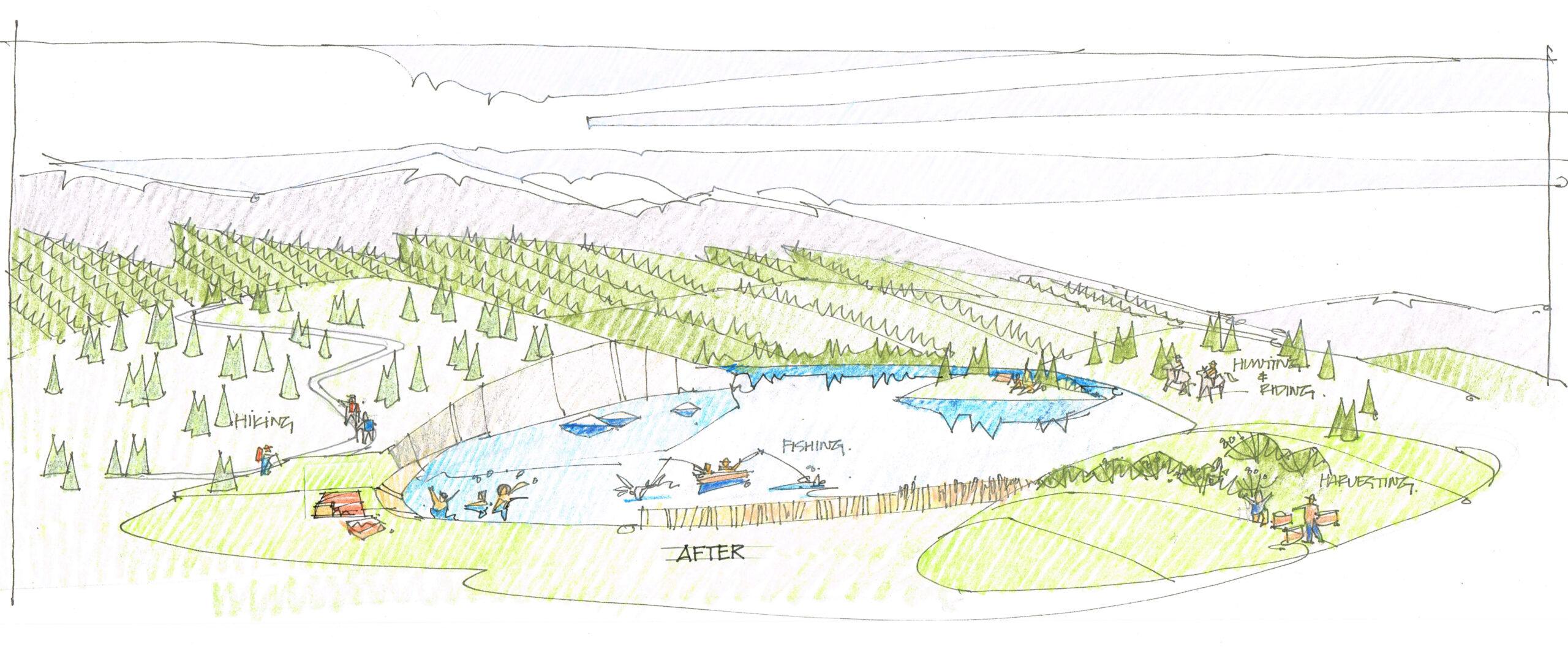
Project Champion: Jeremy Mitchell, BSc, EIT
Jeremy Mitchell is an engineer-in-training based in Calgary, Canada, focusing on providing clients with sustainable tailings, mine rock, and water management solutions which mitigate mining risks to the surrounding environment and communities. Mismanagement of mine material over a mine’s operational timeline can have negative effects on their post closure landscapes, which is why Jeremy is so passionate about helping operational mines make practical and sustainable mine waste management decisions with closure in mind.
Through involvement in Research and Development, Jeremy hopes to lead the team in developing a land use strategy roadmap which can be easily integrated into day-to-day decision making at the operational level in order to ensure mine operators are well prepared for closure, and are able to effectively return reclaimed land back to its surrounding environment.
It has long been recognized that scaling up of standard industry kinetic tools can be problematic in predicting long term water quality.
Okane’s Advanced Customizable Leachate Columns (ACLCs) assess seepage chemistry in a controlled manner representative of in-situ temperature, moisture, and pore gas fluxes to better replicate site conditions, reducing the need for scaling when modelling.
In 2023, our team is collaborating with research institutions and industry partners to evaluate upgrades to ACLC construction materials, control systems, automated monitoring equipment and procedures to assess the application of the ACLC programs to a wider range of materials and site conditions.
Project Champion: Mark Phillip, MSc
Mark Phillip is a senior environmental engineer based in Butte, U.S.A., leading Okane's Environmental Monitoring and Advanced Data Management. He has extensive experience with cover system field trials and performance monitoring systems. His expertise includes integrating laboratory and field testing to assess compaction trials and develop quality assurance/quality control specifications.
Okane’s ACLCs provide the opportunity to assess seepage chemistry in a controlled manner representative of in-situ temperature, moisture, and pore gas fluxes. Mark is exploring upgrades to ACLC construction materials, control systems, automated monitoring equipment, and procedures to provide improved confidence in evaluating site-specific in-situ conditions.
2020-2021
Okane has developed an innovative way to simulate site specific conditions in the laboratory using our ACLCs, and research teams are working to improve design and automation of these columns.
In addition, we are collaborating with research institutions to complete microbiological testing within the columns to enhance institutional knowledge of the inner workings of mine rock storage and tailings facilities.
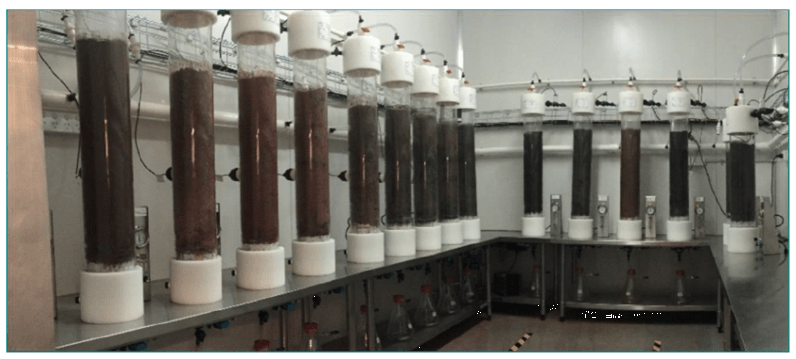
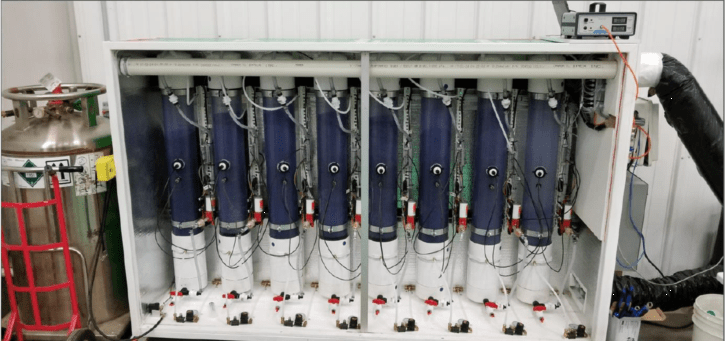
Project Champion: Dr. Jared Robertson, PhD, PEng
Jared Robertson is a senior geochemist based in Saskatoon, Canada, focusing primarily on different modelling approaches of acid and metalliferous drainage processes (AMD) and leading the development of Okane’s ACLCs in the Saskatoon laboratory. Jared has provided geochemical support for clients around the world by connecting the geochemistry of their site to improved closure outcomes. Having spent several years in academia, Jared enjoys applying research and development findings to larger scale settings. Developing the industry’s understanding of AMD processes is a critical component to helping Okane’s clients.
Project Champion: Miguel Jerome, BSc, GDip Eng
Miguel Jerome studied mechanical engineering and has had the opportunity to work in a multidisciplinary role. He is involved in the management of the Perth laboratory, creating Standard Operating Procedures (SOPs), completing data management, and ensuring tests and processes are completed according to relevant practices. Miguel has site experience conducting routine inspections, maintenance, instrument installation, data collection and interpretation of performance monitoring data in Western Australia. He has extensive experience operating the ACLCs. Miguel believes that R&D is an important aspect of work at Okane. Through R&D, we can improve our current processes and increase the efficiency and productivity of our projects, which ultimately helps reduce operational costs.
Okane is in the unique position of having collected 25 years of environmental data specific to the mining industry, representing climates all over the world.
Our research and development team is working to formalize our years of experience into usable datasets that could help mining companies develop better predictive models to evaluate long term environmental performance.
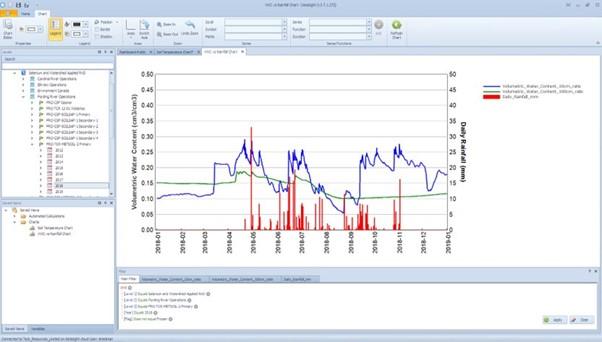
Project Champion: Amy Heidman, MSc, PAg
Amy Heidman is a senior geoscientist with a combined background in chemical engineering technology and land reclamation to complete her post-graduate work in soil bioremediation. She has experience working in oilsands reclamation and has since contributed to cover system and mine rock stockpile monitoring programs at various projects around the world. Her expertise is data management using SQL managed databases and she advocates robust data collection and storage to support R&D projects. Long-term monitoring is crucial for understanding ecosystem development and geochemistry of mine material, and data Okane collects and analyses is an important contribution to these fields of study.
Okane has a long history of collaborating with industry and research institutions to help drive innovation in our industry.
Our technical experts are providing technical guidance and facilitating collaboration for the investigation of controls on geomembrane leakage to further understanding of this process and its implications to the industry.
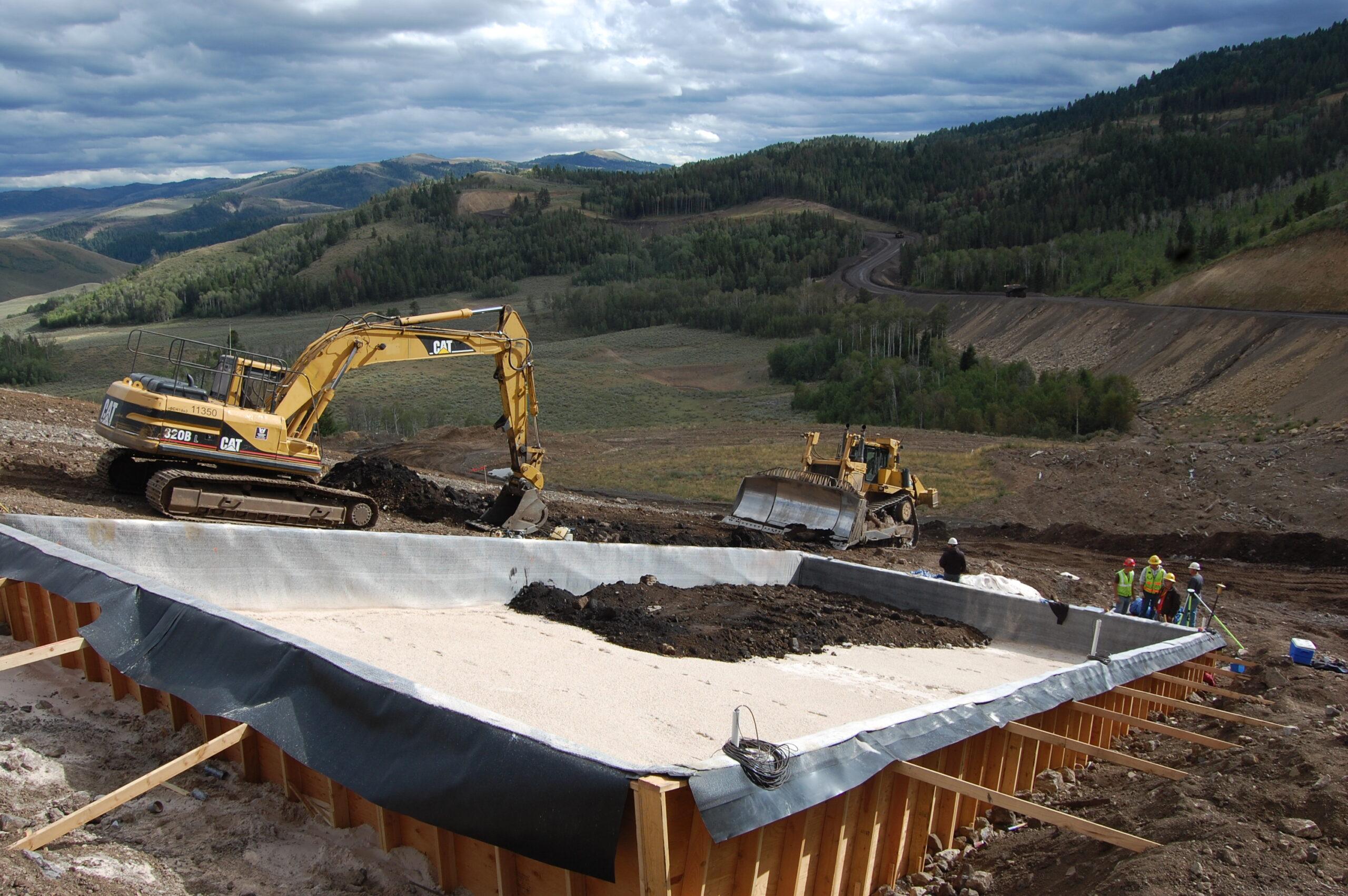
Project Champion: Mark Phillip, MSc
Mark Phillip is a senior environmental engineer based in Butte, U.S.A., leading Okane's Environmental Monitoring and Advanced Data Management. He has extensive experience with cover system field trials and performance monitoring systems. His expertise includes integrating laboratory and field testing to assess compaction trials and develop quality assurance/quality control specifications.
Okane’s Advanced Customizable Leachate Columns (ACLCs) provide the opportunity to assess seepage chemistry in a controlled manner representative of in-situ temperature, moisture, and pore gas fluxes. Mark is exploring upgrades to ACLC construction materials, control systems, automated monitoring equipment, and procedures to provide improved confidence in evaluating site-specific in-situ conditions.
Okane has extensive experience in landform design, including landform evolution and erosion modelling.
Our research and development team is in the process of developing a position paper to outline our preferred methods for this type of predictive modelling, to further knowledge on this topic.
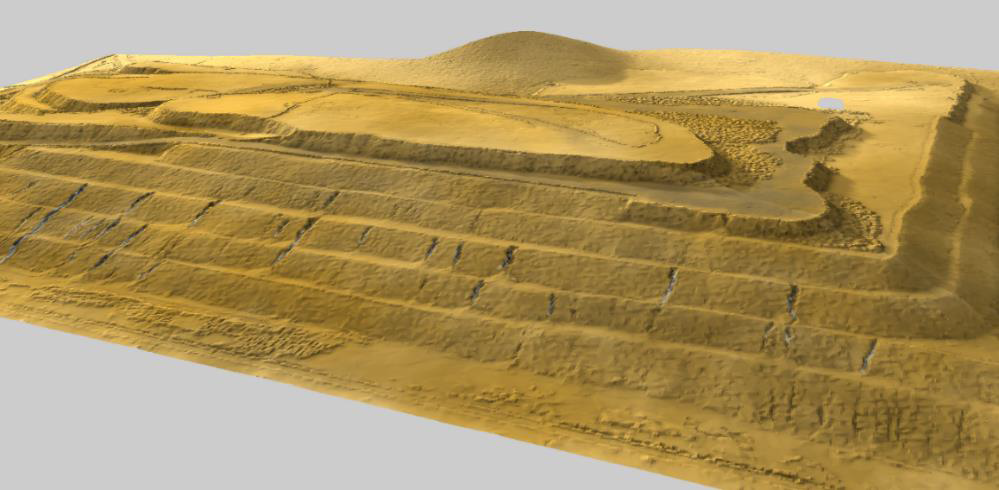
Project Champion: Ian Taylor, BEng Env Hons, MIEAus
Ian Taylor is a senior environmental engineer based in Perth, Australia, with 17 years of experience in civil and mining projects, mine rehabilitation and closure, and related geo-environmental projects. Ian has extensive experience in mine landform design, surface water design and assessment, hydrology/hydraulics, landform evolution assessments, and erosional stability assessments. Ian continues his professional development through industry conferences and targeted research programs. Erosion research is a specific area of interest for Ian as understanding the science of erosion processes is key to engineering inherently stable landform designs.
Okane is committed to cultivating institutional knowledge.
Our project champion is writing a journal paper regarding the hydrogeological and geochemical components of a Hydrology and Geochemical Model, to further knowledge of mine rock stockpile management.

Project Champion: Dr. Jared Robertson, PhD, PEng
Jared Robertson is a senior geochemist based in Saskatoon, Canada, focusing primarily on different modelling approaches of acid and metalliferous drainage (AMD) processes and leading the development of Okane’s Advanced Customizable Leachate Columns (ACLCs) in the Saskatoon laboratory. Jared has provided geochemical support for clients around the world by connecting the geochemistry of their site to improved closure outcomes. Having spent several years in academia, Jared enjoys applying research and development findings to larger scale settings. Developing the industry’s understanding of AMD processes is a critical component to helping Okane’s clients.
Okane is a leading innovator in the development of digital twins and predictive modelling for mined rock management.
Our research and development team are in the process of developing enhanced add-ins to commercially available software to decrease modelling turnaround times and increase accuracy of their predictive capabilities.
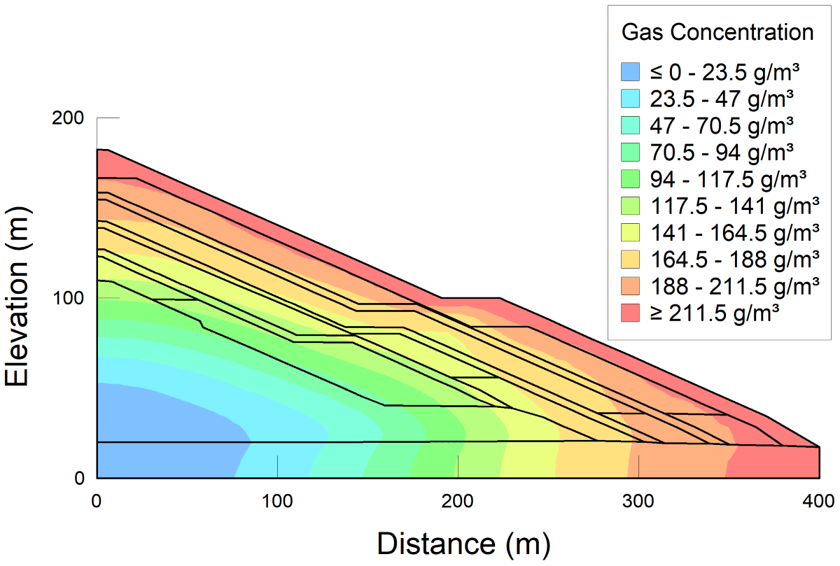
Project Champion: Robert Shurniak, MSc, PEng
Robert Shurniak is a senior engineer based in British Columbia, with expertise in using and developing numerical models as they relate to mine closure planning—specifically, simulating soil-plant-atmosphere and saturated/unsaturated water movement over, around and through any material or vegetation used in mine operations and closure. Since 2002, Robert has supervised, managed, and advised on numerous numerical modelling projects. Robert has developed over 50 long-term climate databases, accounting for historical climate and predicted future climate change, for a range of sites (arctic to arid) around the world. He also has experience designing, installing, and maintaining field monitoring systems and evaluating the results from such installations.
Robert is the Numerical Modelling Group Leader for Okane and he ensures all modelling projects are completed to Okane’s high standards using state-of-the-art modelling software. Research and development of new modelling tools for simulating mine rock storage (MRS) are a priority at Okane, as MRSs typically generate about 80% of a site’s overall acid rock drainage and metal leaching (ARD-ML) load. Modelling tools are important for determining the impetus for ARD-ML generation at a given site and to test potential mitigation methods.
Get in touch with our team to further explore our solutions.
We are dedicated to fostering meaningful partnerships and advocating for positive outcomes for all community stakeholders and rightsholders.
Let's collaborate towards responsibly and safely returning mine-affected lands.
